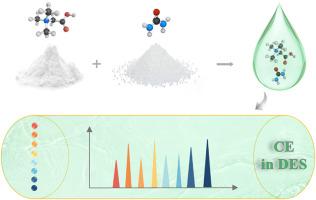Capillary electrophoresis separations with Betaine:Urea, a deep eutectic solvent as the separation medium
IF 5.7
2区 化学
Q1 CHEMISTRY, ANALYTICAL
引用次数: 0
Abstract
Background
Capillary electrophoresis (CE) is a highly versatile separation technique widely used in analytical chemistry. Traditionally, CE can be categorized as either aqueous or non-aqueous systems based on the buffer solvents employed. For decades, non-aqueous CE has been predominantly associated with the use of organic solvents, a perception deeply ingrained in the scientific community. However, growing concerns about the health and environmental impacts of these solvents, driven by the principles of green chemistry, have prompted a reevaluation of their use. In response to these concerns, our group recently introduced a deep eutectic solvent (DES), specifically Proline:Urea, as an innovative and eco-friendly separation medium for CE. This approach not only enhances the sustainability of CE separations but also offers a new perspective for the development of innovative CE separation media.Results
Building on our previous work, here we report the use of the second DES, Betaine:Urea (BU), as a new separation medium that offers further improved performance for CE applications. The DES was systematically characterized, with key physical properties relevant to CE separations, such as thermal properties, viscosity, dielectric constant, Joule heating effect, and UV transmittance, being thoroughly examined. Using a complex sample of 10 structurally similar naphthalene derivatives, we demonstrated the efficiency of BU in capillary zone electrophoresis (CZE) for separating analytes with varying charges (including cations, neutrals, and anions) and sizes. Additionally, we established the first micellar electrokinetic chromatography (MEKC) system in this DES using sodium dodecyl sulfate (SDS) as the surfactant. This system successfully resolved 6 structurally similar neutrals that could not be separated by conventional aqueous SDS-MEKC, highlighting the versatility of this DES-type separation medium. Furthermore, BU showed several advantages over the previously reported DES, Proline:Urea, particularly in terms of stability, viscosity, and Joule heating effects.Significance
This study holds the potential to challenge the traditional notion that “CE separation media are merely categorized into aqueous and organic solvents”. Given that DESs are “designer” solvents with highly tunable properties and environmentally friendly characteristics, the introduction of BU as a viable alternative to traditional solvents not only expands the media available for CE separations, but also offers a more efficient and potentially more sustainable option for specific analyses.

使用甜菜碱:尿素(一种深共晶溶剂)作为毛细管电泳分离介质
背景毛细管电泳(CE)是一种广泛应用于分析化学的多功能分离技术。传统上,根据所使用的缓冲溶剂,毛细管电泳可分为水溶液系统和非水溶液系统。几十年来,非水 CE 主要与使用有机溶剂有关,这种观念在科学界根深蒂固。然而,在绿色化学原则的推动下,人们越来越关注这些溶剂对健康和环境的影响,这促使人们重新评估这些溶剂的使用。针对这些问题,我们小组最近推出了一种深共晶溶剂 (DES),特别是脯氨酸:尿素,作为一种创新的生态友好型 CE 分离介质。这种方法不仅提高了 CE 分离的可持续性,还为开发创新型 CE 分离介质提供了新的视角。结果在之前工作的基础上,我们在此报告了第二种 DES(甜菜碱:尿素 (BU))的使用情况,作为一种新的分离介质,它能进一步提高 CE 应用的性能。我们对 DES 进行了系统表征,并对与 CE 分离相关的关键物理性质(如热性能、粘度、介电常数、焦耳热效应和紫外线透过率)进行了全面检查。利用 10 种结构相似的萘衍生物的复杂样品,我们证明了 BU 在毛细管区带电泳 (CZE) 中分离不同电荷(包括阳离子、中性离子和阴离子)和大小的分析物的效率。此外,我们还利用十二烷基硫酸钠(SDS)作为表面活性剂,在该 DES 中建立了首个胶束电动色谱(MEKC)系统。该系统成功分离了 6 种结构相似的中性物质,这些物质无法通过传统的水性 SDS-MEKC 分离出来,这凸显了这种 DES 型分离介质的多功能性。此外,BU 与之前报道过的 DES(脯氨酸:尿素)相比,尤其是在稳定性、粘度和焦耳加热效应方面,显示出了若干优势。鉴于 DES 是一种 "设计型 "溶剂,具有高度可调的特性和环境友好型特征,因此引入 BU 作为传统溶剂的可行替代品,不仅扩大了可用于 CE 分离的介质范围,而且还为特定分析提供了一种更高效、可能更具可持续性的选择。
本文章由计算机程序翻译,如有差异,请以英文原文为准。
求助全文
约1分钟内获得全文
求助全文
来源期刊

Analytica Chimica Acta
化学-分析化学
CiteScore
10.40
自引率
6.50%
发文量
1081
审稿时长
38 days
期刊介绍:
Analytica Chimica Acta has an open access mirror journal Analytica Chimica Acta: X, sharing the same aims and scope, editorial team, submission system and rigorous peer review.
Analytica Chimica Acta provides a forum for the rapid publication of original research, and critical, comprehensive reviews dealing with all aspects of fundamental and applied modern analytical chemistry. The journal welcomes the submission of research papers which report studies concerning the development of new and significant analytical methodologies. In determining the suitability of submitted articles for publication, particular scrutiny will be placed on the degree of novelty and impact of the research and the extent to which it adds to the existing body of knowledge in analytical chemistry.
 求助内容:
求助内容: 应助结果提醒方式:
应助结果提醒方式:


